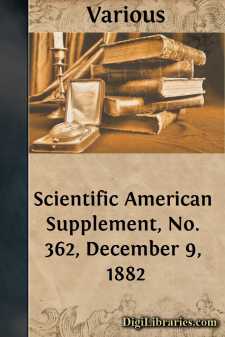Categories
- Antiques & Collectibles 13
- Architecture 36
- Art 48
- Bibles 22
- Biography & Autobiography 813
- Body, Mind & Spirit 142
- Business & Economics 28
- Children's Books 14
- Children's Fiction 11
- Computers 4
- Cooking 94
- Crafts & Hobbies 4
- Drama 346
- Education 46
- Family & Relationships 57
- Fiction 11829
- Games 19
- Gardening 17
- Health & Fitness 34
- History 1377
- House & Home 1
- Humor 147
- Juvenile Fiction 1873
- Juvenile Nonfiction 202
- Language Arts & Disciplines 88
- Law 16
- Literary Collections 686
- Literary Criticism 179
- Mathematics 13
- Medical 41
- Music 40
- Nature 179
- Non-Classifiable 1768
- Performing Arts 7
- Periodicals 1453
- Philosophy 64
- Photography 2
- Poetry 896
- Political Science 203
- Psychology 42
- Reference 154
- Religion 513
- Science 126
- Self-Help 84
- Social Science 81
- Sports & Recreation 34
- Study Aids 3
- Technology & Engineering 59
- Transportation 23
- Travel 463
- True Crime 29
Scientific American Supplement, No. 362, December 9, 1882
by: Various
Categories:
Description:
Excerpt
GUSTAVE TROUVÉ.
The accompanying portrait of M. Gustave Trouvé is taken from a small volume devoted to an account of his labors recently published by M. Georges Dary. M. Trouvé, who may be said to have had no ancestors from an electric point of view, was born in 1839 in the little village of Haye-Descartes. He was sent by his parents to the College of Chinon, whence he entered the École des Arts et Metiers, and afterward went to Paris to work in the shop of a clock-maker. This was an excellent apprenticeship for our future electrician, since it is in small works that electricity excels; and, if its domain is to be increased, it is only on condition that the electric mechanician shall never lose sight of the fact that he should be a clock-maker, and that his fingers, to use M. Dumas's apt words, should possess at once the strength of those of the Titans and the delicacy of those of fairies. It was not long ere Trouvé set up a shop of his own, whither inventors flocked in crowds; and the work he did for these soon gave up to him the secrets of the art of creating. The first applications that he attempted related to the use of electricity in surgery, a wonderfully fecund branch, but one whose importance was scarcely suspected, notwithstanding the results already obtained through the application of the insufflation pile to galvano-cautery. What the surgeon needed was to see plainly into the cavities of the human body. Trouvé found a means of lighting these up with lamps whose illuminating power was fitted for that sort of exploration. This new mode of illumination having been adopted, it was but natural that it should afterward find an application in dangerous mines, powder mills, and for a host of different purposes. But the perfection of this sort of instruments was the wound explorer, by the aid of which a great surgeon sounded the wounds that Italian balls had made in Garibaldi's foot.
[Illustration: GUSTAVE TROUVE.]
The misfortunes of France afterward directed Trouvé's attention to military electricity, and led him to devise a perfect system of portable telegraphy, in which his hermetic pile lends itself perfectly to all maneuvers and withstands all sorts of moving about.
The small volume of which we have spoken is devoted more particularly to electric navigation, for which M. Trouvé specially designed the motor of his invention, and by the aid of which he performed numerous experiments on the ocean, on the Seine at Paris, and before Rouen and at Troyes. In this latter case M. Trouvé gained a medal of honor on the occasion of a regatta. Our engraving represents him competing with the rowers of whom he kept ahead with so distinguished success. We could not undertake to enumerate all the inventions which we owe to M. Trouvé; but we cannot, however, omit mention of the pendulum escapement that beats the second or half second without any variation in the length of the balance; of the electric gyroscope constructed at the request of M. Louis Foucault; of the electro-medical pocket-case; of the apparatus for determining the most advantageous inclination to give a helix; of the electric bit for stopping unruly horses; and of the universal caustic-holder....












